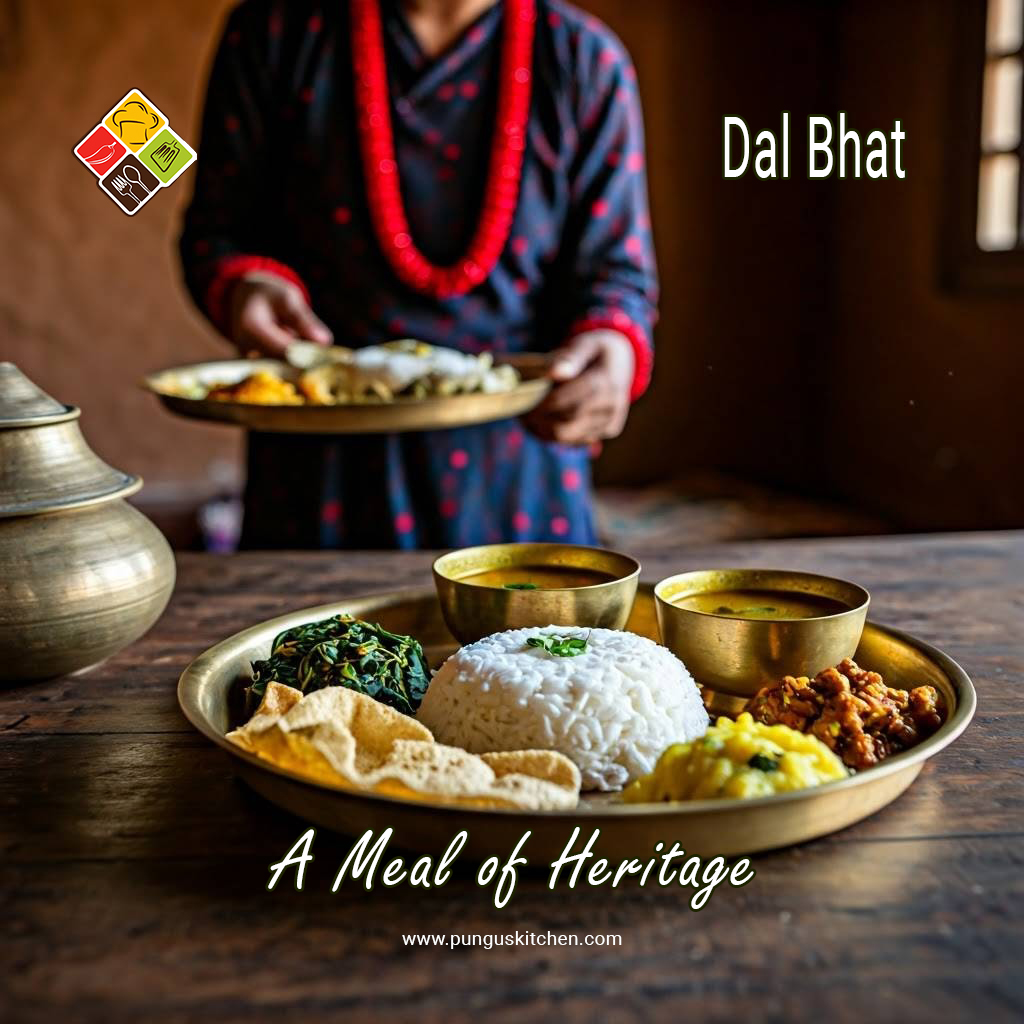Dal Bhat Uncovered – The Meal That Feeds Millions Daily

Across the South Asian subcontinent, especially in Nepal, India, and Bhutan, there’s one dish that unites people across regions, cultures, and traditions—Dal Bhat. This humble yet profoundly nourishing meal is more than just food. It’s a way of life. A comforting, sustaining combination of lentils and rice, Dal Bhat has been a staple for generations.
In this article, we explore the origins, cultural importance, variations, health benefits, preparation methods, and modern relevance of Dal Bhat. Whether you’re a curious foodie or someone longing for a taste of home, this in-depth guide will take you on a delicious journey through one of South Asia’s most iconic meals.
What Exactly is Dal Bhat?
In the simplest terms, Dal Bhat is a dish made of two main components:
- Dal: A spiced lentil soup, usually made from split pulses like masoor (red lentils), mung (green gram), toor (pigeon peas), or chana dal. It is simmered with turmeric and salt and tempered with aromatics like garlic, cumin, mustard seeds, and sometimes ghee for added richness.
- Bhat: Steamed or boiled rice—typically white rice, though brown rice or red rice is used in some regions.
Served together, Dal Bhat forms a complete and balanced meal. The combination of lentils and rice provides all nine essential amino acids, making it a perfect protein source, especially for vegetarians.
The Cultural and Historical Roots of Dal Bhat
Food isn’t just about sustenance—it’s about identity, history, and continuity. Dal Bhat holds a significant place in the cultural consciousness of South Asia. In Nepal, it is the national dish. In Bihar, Bengal, and Assam, it is an everyday comfort. In Bhutan, variations of it are deeply ingrained in local food culture.
Historically, the affordability and accessibility of rice and lentils made Dal Bhat a staple for rural households. Its preparation doesn’t require expensive spices or complex techniques. And yet, despite its simplicity, it provides a deeply satisfying eating experience.
In the Himalayas, trekkers and mountaineers swear by the energy-packed combination of Dal Bhat. The popular saying “Dal Bhat power, 24 hour” is more than a joke—it’s a testament to the meal’s ability to fuel long, arduous journeys.
Regional Variations of Dal Bhat
While the core elements of Dal Bhat remain consistent, the regional twists are what make it extraordinary. Here’s how different parts of South Asia interpret this iconic dish:
Nepal
- Served with seasonal vegetables (tarkari), leafy greens (saag), spicy pickles (achar), and sometimes yogurt or a meat curry.
- Usually accompanied by a wedge of lemon and green chili for added freshness and spice.
India (Bihar, Bengal, Assam, Odisha)
- Bihar: Often paired with aloo chokha (mashed spiced potatoes), baingan bharta, and mustard-oil pickles.
- Bengal: Comes with fried eggplant, green chili, and sometimes a piece of fried fish or egg curry.
- Assam: May include a simple fish curry, sour dal, and bamboo shoot chutney.
- Odisha: Includes pakhala (fermented rice water version), spiced dal, and fried vegetables.
Bhutan
- Uses red rice and may include ema datshi (chili and cheese curry) as a spicy side dish.
- Hearty and deeply flavorful with fermented vegetables and chilies.
Health and Nutritional Benefits of Dal Bhat
Dal Bhat is a power-packed meal that fits beautifully into both traditional and modern wellness-focused diets. Here’s why:
- Complete Protein: The combination of lentils and rice provides all essential amino acids.
- High in Fiber: Lentils support gut health and aid digestion, while brown rice variants increase fiber intake.
- Low in Saturated Fat: Unless cooked with a lot of ghee or oil, it’s heart-healthy and low-fat.
- Rich in Micronutrients: Dal provides iron, folate, magnesium, and zinc. Rice offers carbohydrates for energy.
For vegetarians, diabetics, and anyone looking for a wholesome, filling, and affordable meal, Dal Bhat ticks all the boxes.
Modern Take on Dal Bhat
As global diets evolve, Dal Bhat remains surprisingly adaptable. From vegan protein bowls to Ayurvedic meal plans, this dish is gaining popularity in wellness and fusion cuisine circles.
Health-conscious cooks may substitute white rice with quinoa, brown rice, or millet. Dal is often enriched with spinach, moringa, or carrots for added nutrition. In urban kitchens, the dish finds its place in bento boxes, meal preps, and gourmet menus alike.
Watch How Dal Bhat Is Made

Disclaimer & Courtesy: The video above is for educational and cultural awareness purposes. All rights belong to the original content creator. Watch more food heritage content on History of Food Channel.
View the Full Recipe
Ready to cook this nourishing dish at home? Click here to view the full Dal Bhat recipe with step-by-step instructions, ingredients list, and tips for beginners.
We’d Love to Hear from You!
Have you tried Dal Bhat before? Do you have memories or tips to share from your family kitchen? Comment below with your thoughts, experiences, and suggestions—we’d love to hear how this dish plays a role in your life!


You Might Also Like
Helping Hands Are More Powerful Than Praying Lips.
Prayers bring comfort, but true change begins with action. A helping hand...
Parenting & Cooking: A Working Woman’s Balance
As a working woman, the juggle between career, family, and household responsibilities...
Unlock the Umami Secret: Understanding MSG
Ajinomoto's most famous seasoning is AJI-NO-MOTO®, which is a monosodium glutamate (MSG) product. It is...
International Mother’s Day: A Celebration of Unconditional Love and Nurturing Souls.
Celebrate the love, sacrifice, and nurturing spirit of mothers this International Mother's...
Chicken 65: South India’s Culinary Pride Shines Globally
Chicken 65, a popular South Indian dish, has received global recognition once...
India’s Favorite Foods of 2024: How Biryani Continues to Rule the Nation’s Palate
Biryani remains India’s most loved dish in 2024, followed by pizza, tea,...